In the busy world of beauty eCommerce, where a multitude of brands are constantly vying for attention, mastering SEO has become imperative for any beauty retailer looking to stand out and grow their ecommerce revenue.
Whether you’re a seasoned beauty retailer or just starting your eCommerce journey, this guide will equip you with the knowledge and tools needed to navigate the ever-changing SEO landscape, and set your brand up for success.
Keyword research
The keyword research process is a vital part of working with any industry, but in a vertical like beauty where the product range is so diverse and the questions people have seemingly-infinite, it becomes even more important.
Performing good keyword research is about more than just finding some high-volume search terms – it’s about getting to know your audience. By the end of the research process, you should have a much more complete understanding of exactly what questions your customers are asking and what they want from you.
When performing keyword research, you can make use of the following resources:
- Google products such as Google Ads and Google Trends
- SEO tools like Semrush and Ahrefs
- Online message boards like Reddit
- Social media platforms like YouTube and TikTok (what topics are commonly discussed and what questions do you often see answered in content?)
- Your competition and the major eCommerce sites in the space.
As an example, if you were selling skincare products, the keyword research process might involve:
- Heading to the Semrush keyword magic tool and entering a term like ‘moisturisers’. Add the relevant keywords it suggests to your keyword list.
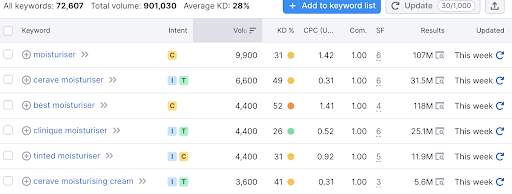
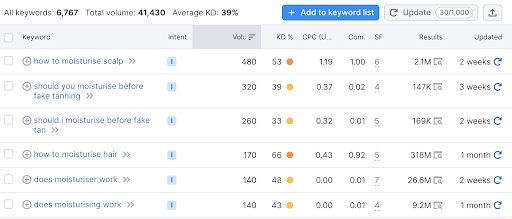
- Your next step might be to head over to the SkincareAddiction subreddit, which has over 2,200,000 members and an incredibly active community of skincare enthusiasts. You can use this to dig deeper into what real users are asking day-to-day. The first two threads alone would make excellent pieces of content for your blog:
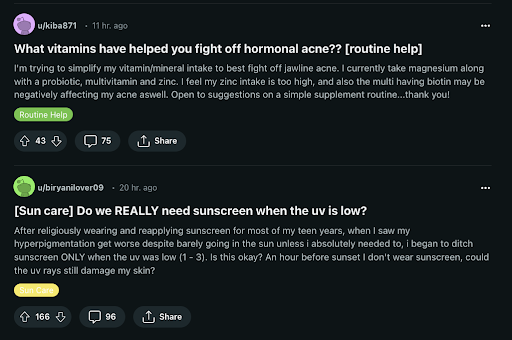
- Next up, you might head over to YouTube, which has a ton of creators putting out incredible beauty content every day. One of those creators is Huda Beauty, so you might head over to her page and start looking through her videos – sort them by most popular to get a real sense of what the audience is most interested in.
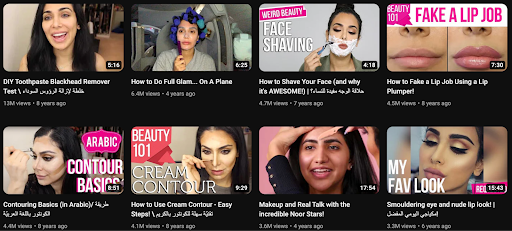
- Next up you might want to look at your competitors. Cult Beauty is one of the biggest players in the space, so looking at what they’re doing is a good way to find out what users are looking for. You can start by looking at their navigation and browsing their categories to see how they break down products and how you might want to group your own website.
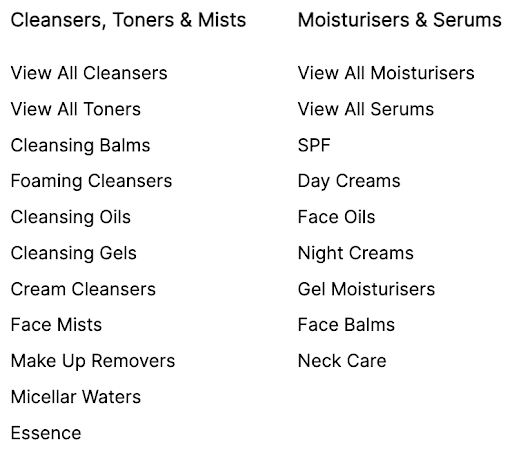
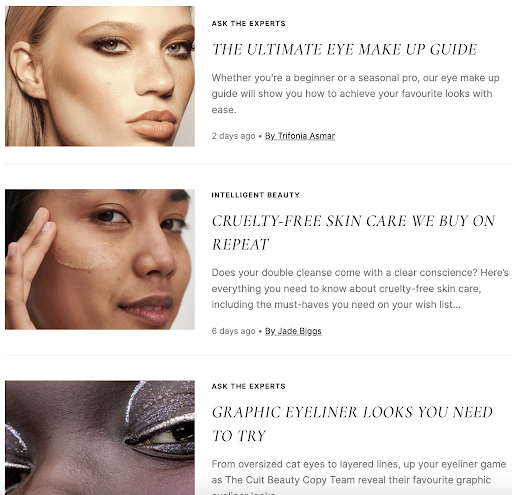
- Once you’ve done all this, you should have a huge list of potential keywords. It’s then down to you to put these keywords into relevant groups and prioritise accordingly. Tools such as Google Trends can also be a great help here, as you can get a quick snapshot of whether searches for a top-level term are trending up or down and what seasonality is like to give you a better handle on how to effectively prioritise.
Use other platforms
When you think about an SEO strategy, Google will naturally be at the front of your mind. When you’re operating in the beauty industry, however, this represents an especially large missed opportunity.
According to a recent Share of Voice report, YouTube is the second most popular beauty related website in the UK. It’s also the world’s second largest search engine. Apps like TikTok also play host to huge beauty communities – and users use it the same way you’d expect them to use Google: searching for answers to their burning questions.
If you really want to maximise your online performance, taking a smart approach to optimising for these channels is vital. While these channels may fall under the responsibility of the social media team, aligning them with your organic strategy is an easy win.
When you’ve developed your SEO content strategy, which will naturally include pieces of content where video is the most appropriate solution, align with your social media team. You can provide guidance on pieces of content which might perform well and use them to drive qualified traffic once they’ve been created, and they get some great data-driven content ideas too.
In doing this, the business as a whole wins and you help drive organic reach across all platforms using search, rather than just Google.
Consider all phases of the customer journey
When you start developing an eCommerce SEO strategy, one of your major KPIs will typically be to drive increased non-brand organic traffic to category pages. And while that will drive real growth, your category pages are just one part of your website. Ignoring other areas can have a real impact, especially in an industry where considered, informed purchases are common.
A detailed keyword research strategy about any product group within the beauty industry will typically reveal a host of specific questions people have, alongside searches for specific products.
For example, foundation is a standard base used when applying makeup, meaning this category page will usually be a prime optimisation target. A quick review of the data, however, reveals people do much more than just search for the right foundation for their skin tone. They’re also looking for information such as:
- How to apply foundation
- How concealer works with foundation
- Foundation for different skin types (such as acne or dry skin)
- Whether water or silicone-based foundations are optimal
- Serum vs powder foundations…And much more.
All of these searches are being performed by people at different stages of the buying cycle, but they all have the potential to convert into paying customers. Content like this also supports your category pages and helps them rank by enhancing your overall authority.
So, while building out and optimising the next set of category pages might be tempting, taking a step back to ensure you’re helping customers at different stages of the purchase cycle for those you already have is a vital part of building a solid SEO strategy.
Define your organic competitors
Every business has a defined set of competitors, and beauty eCommerce businesses are no different. You may look at market leaders such as Look Fantastic as a key competitor, as you attempt to eat away at some of their market share. If you’re a smaller, up-and-coming brand you’ll also look at other brands of a similar size with similar ambitions as key competitors.
While having those traditional competitors established is no bad thing, it’s important not to forget one key group: the brands who currently rank for the searches you’re targeting.
This additional competitor set is often more flexible than the others and, depending on how you work, could even change on a quarterly basis. But when you’re measuring performance of an SEO strategy, reviewing how well those around you in the SERPs are doing in comparison is a vital piece of the puzzle.
If you have a quarterly target of improving organic revenue of your vitamin C serums by 15% year-on-year, for example, your non-ranking main competitor isn’t a great indicator of how well you’ve done compared to the rest of the market in this space. Instead, you should look at who’s ranking for the key vitamin C searches you’ve identified.
Once you have this information, you have a much better handle on how you’re performing organically compared to the rest of the industry for this group of search terms, and gain much more relevant information when performing a keyword gap analysis and other pieces of research.
Get specific
As we’ve already mentioned, consumers in the beauty industry have very specific needs. If you want to drive organic traffic and attract customers, properly meeting these needs is of vital importance.
When you’re performing keyword research, don’t dismiss keywords with a low search volume out of hand. While some of them may not be worth focusing on, others will convert well with the right page. The keyword ‘best anti-ageing foundation for mature skin’, which only has a search volume of 20, is a great example of this.
It’s also important to not get too caught up on volumes for individual keywords like this. A page meeting intent for this keyword will also rank for a range of other searches around anti-ageing foundation, meaning the actual traffic potential is much higher than the handful of visits a month the keyword level volume suggests.
You can meet intent for specific keywords in a number of ways, such as:
- Focused subcategory pages which sit beneath your main category page (/foundation/anti-ageing-foundation, for example)
- Blog content designed to educate and inform, which features relevant internal links (The 10 best anti-ageing foundations)
- Effective use of filter pages to meet a huge range of specific search queries en-masse. (Note: doing this incorrectly can result in index bloat and serious technical issues, so proceed with caution.)
Answer customer questions
The humble blog is commonly overlooked, especially in the eCommerce industry. Companies which have a blog because “you just have to have one for content” then use it to hold press releases and the occasional article a lone member of staff has to write every month or two is incredibly common.
The logic? Blogs don’t drive direct sales. And honestly, they’re (sometimes) right. That doesn’t mean you should do what they do though.
In the beauty industry specifically, having an in-depth blog which answers all your customers key questions can play a vital role in driving valuable traffic and building your brand. After all, if you’re the trusted resource for any beauty related questions, where do you think people will go the next time they’re shopping for a new product?
While this may not show as a direct sale for your blog in your reporting, that focus on answering users’ questions contributed massively to making that sale.
Answering questions doesn’t need to be limited to your blog, either. Providing detailed answers to everything users want to know on your product pages will also improve your conversion rate. You can see this done well on Look Fantastic, where products have information such as:
- A complete description of what the product helps you achieve and how it does so
- Guidance on how to use the product
- A complete ingredients list for people to easily review
Every question a potential customer could ask is answered on their product pages – meaning people don’t need to look (and potentially convert) elsewhere to find more information.
Check your tech
Of course, you can answer every possible question your potential customers have, but if Google can’t properly crawl and index your site you won’t rank, and if people can’t browse your site, they won’t convert.
Ask yourself some common technical SEO questions before you go full steam ahead on creating the best content in history:
- Can Google crawl and index all your relevant pages effectively? Make sure your canonical tags and robots.txt instructions are used properly to ensure only the pages you want Google to check are reviewed, and you have internal links pointing to all your pages.
- Is your website fast? Use tools such as Google’s Core Web Vitals report and GTMetrix to establish how fast your site is and optimise it accordingly. Great site speed both helps improve organic rankings and increases conversion rates.
- Do you have a lot of 404 errors? Having a lot of broken pages is a poor quality signal, wastes crawl budget and is a poor experience for users. Make sure these pages are redirected or all internal links to them are removed.
Of course, there’s a lot more than this to consider from a technical perspective, but these are some of the most common issues. A comprehensive technical SEO audit is a vital part of your success.
Use reviews
The use of product reviews is an important part of any eCommerce strategy because of how important they are for conversion. When you’re buying something, seeing lots of other people have used it and had a good experience is always a great sign after all!
When you’re operating in an industry like beauty, they become even more important for multiple reasons. If someone is buying eyeshadow, reviews, and pictures confirming the actual shade are really helpful and make it a less risky purchase. Someone buying cream for a specific skin type will also want confirmation it works as advertised, and they won’t run into any issues.
As well as helping conversion, detailed reviews are an incredible source of content for the page. Having a large amount of UGC such as reviews will make your product pages much more detailed, meaning they’re much more likely to rank well for the product-based searches we know convert incredibly well.
Optimise your product pages
And speaking of product pages, making sure they’re well optimised is an opportunity you can’t miss. Include the following elements where possible:
- Descriptive H1 and title tag featuring the name of the product.
- A detailed product description which includes all the information users might need. Break down whom the product is right for, the ingredients, how it helps and full instructions on how to use it.
- Great images and videos. A picture of the product is great. Pictures of it in-use on a variety of skin tones and types, plus a video on how to apply it is better.
- Ensure all your rich media is optimised. Compress your files, use next gen image formats and include relevant Alt text and descriptions to extract maximum SEO benefit from all those amazing pictures and videos you’ve uploaded.
- Utilise structured data. Ensuring your products structured data is error-free and contains as much information as possible is a must, but also consider other types you could use like video or FAQ.
Alongside this, you also need to include information on accepted payment methods and delivery options alongside clear pricing. All while making it as simple to buy as possible.
Optimisation is in the eye of the beholder
Ultimately, beauty eCommerce is incredibly competitive and performing well organically isn’t the simplest of tasks. Nonetheless, if you follow these core principles, with a focus on quality and meeting the intent of searchers, you’ll fly up the rankings in no time!Or you could always get in touch to see how we could help your beauty brand improve its eCommerce performance.
Do you work at a UK beauty brand? We’d love to chat to you, and share our industry insights and expertees! Sign up to attend our 19th October Beauty Ecommerce Roundtable in London, for a networking breakfast with other beauty ecommerce marketers, sharing advice, challenges, insights and trends!
Want to stay up to date with the latest beauty ecommerce trends and insights? sign up to receive our next beauty ecommerce report:



